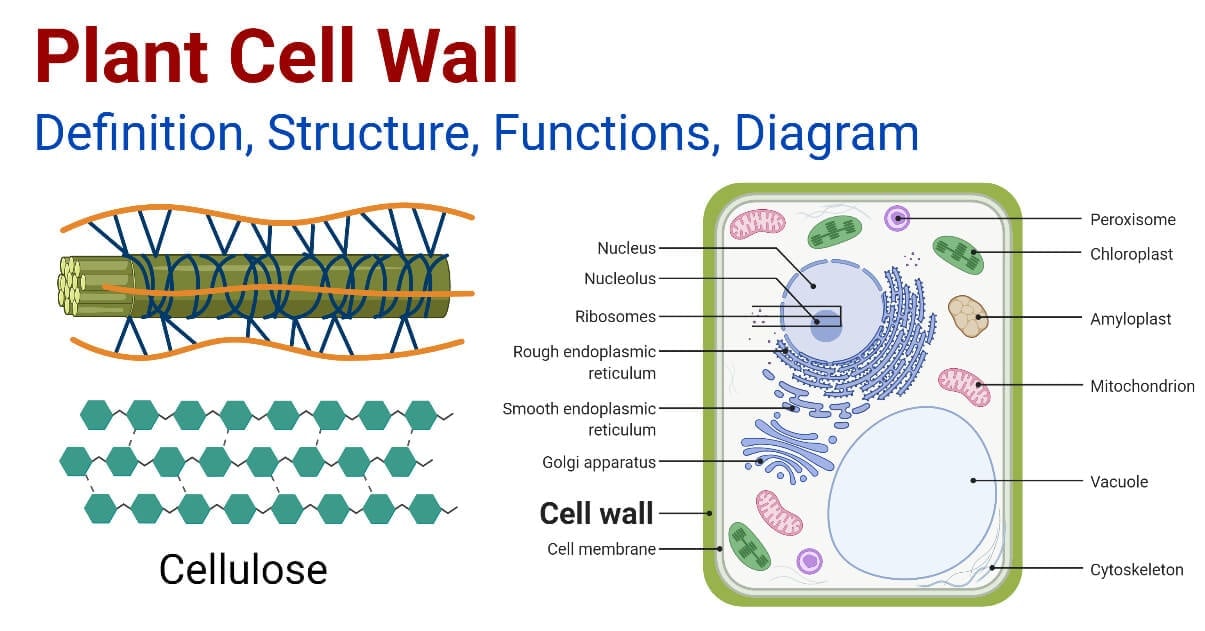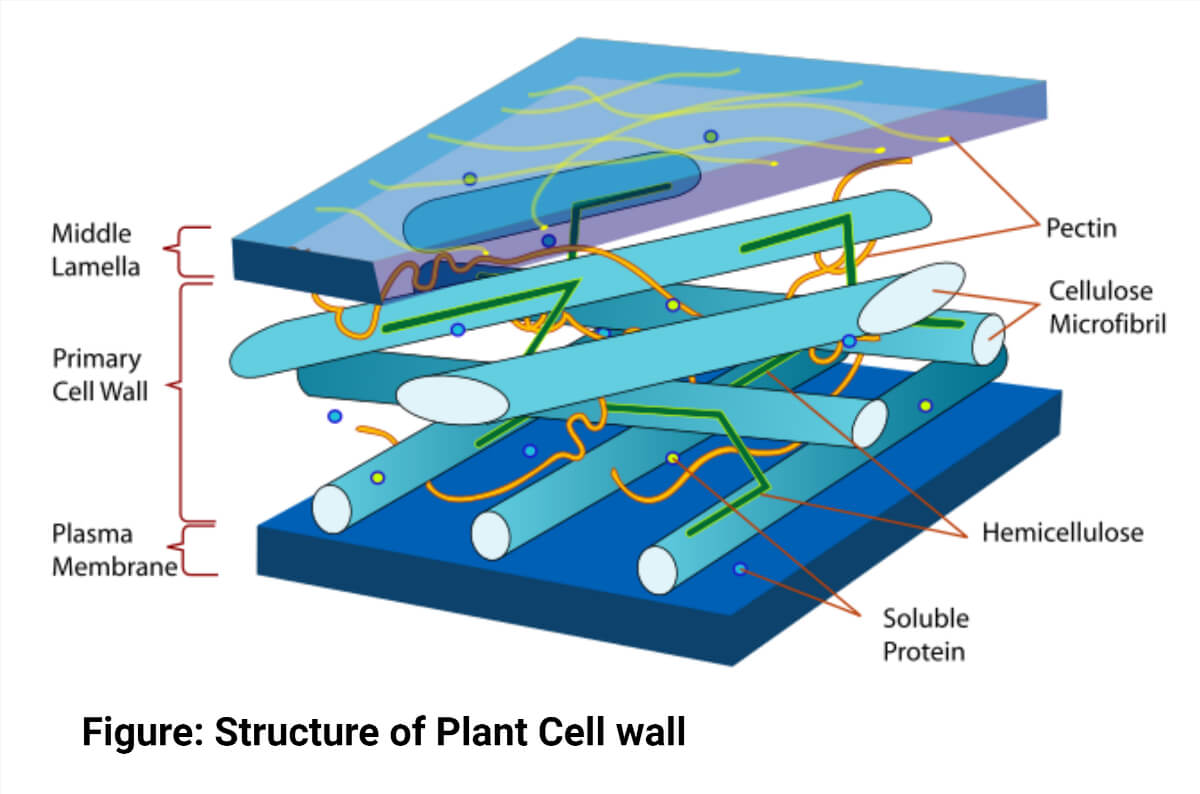- A cell wall is an outer rigid semi-elastic supportive and protective layer.
- It is present around the plasma membrane.
- It provides mechanical support and helps in maintaining the shape of the plant cell.
- The cell wall is present in the plant cell and absent in the animal cell which distinguishes them from each other.
- The cell wall is formed by the protoplast. Any plant cell which is devoid of the cell wall is called the protoplast.
- The plant cell is mostly made up of the following components:
- Cellulose
- Hemicellulose
- Pectin
- Protein

- In both the primary and secondary cell walls of the plant, cellulose is present.
- Cellulose is an insoluble carbohydrate.
- The fibrous structure present in the cell wall maintains the integrity of the structure.
- In the primary cell wall, Pectin is present predominantly.
- It plays the important role in:
- Expansion
- Strength
- Porosity
- Adhesion
- Intercellular signaling
- Other non-cellulosic polysaccharides include xyloglucan, glucan, xylan, mannan, and callose.
- Based on the sugar substitutes and side chains, pectic and non-cellulosic polysaccharides can be distinguished further too.
- During biosynthesis, these components are attached to the polysaccharides.
- These substituents are important in determining the solubility and viscosity within the cell wall.
- They are also responsible for determining the interaction between polysaccharides and proteins.
- The cell wall of fungi is made of chitin.
- The cell wall of bacteria is made of the protein, lipid, and polysaccharides complex.
Interesting Science Videos
Structure of Plant Cell wall
- It is derived from the living protoplast.
- It consists of the middle lamella, primary cell wall, plasmodesmata, secondary cell wall, and pits.
Middle lamella
- After the cytokinesis, it is the first-formed layer.
- It is present in between the two adjacent cells.
- It is made up of calcium and magnesium pectate.
- It helps to join the two adjacent cells.
Primary cell wall
- It is the first formed cell wall.
- It is present in the inner side of the middle lamella.
- It is the thin and permeable layer that can be expanded.
- Cutin and cutin waxes are present in some epidermal cells of the leaf and stem. It makes the primary cell wall impermeable.
- It is formed before the growth and development of the cell.
- It is made up of matrix and microfibrils.
- Matrix is made up of water, hemicelluloses, pectin, lipids, and proteins.
- Microfibrils are embedded in the gel-like matrix.
- The primary cell wall of the plant is made of cellulose.
- In the fungi, chitin makes the primary cell wall, and in bacteria murein makes it.
- Primary cell wall forms the only cell wall in the immature meristematic and parenchymatous cells.
Plasmodesma (plural: plasmodesmata)
- Plasmodesmata are cytoplasmic or protoplasmic bridges present in the primary cell wall of adjacent cells.
- They form a protoplasmic continuum called symplast.
- They transfer cytoplasmic materials among adjacent cells.

Secondary cell wall
- The secondary cell wall is situated inner to the primary cell wall.
- This is the thick layer, permeable, and cannot be expanded.
- It forms after the growth and development of the cell.
- It is present in the cells of the thick-walled dead tissue of the plant. Eg: Cells of sclerenchyma, tracheids, and vessels.
- It is differentiated into the outer layer (S1), middle layer (S2), and inner layer (S3).
- Each layer is made up of a matrix and microfibrils.
- The chemical composition of the matrix is almost similar to the matrix of the primary cell.
- Microfibrils of the secondary cell wall is made up of cellulose and lignin.
- Some chemicals like suberin, silica, wax, resins, oils, etc. are also deposited in the secondary cell wall.
Pits
- In the secondary cell wall, pits are the unthickened areas or depressed areas.
- A pit consists of a pit cavity or pit chamber and pit membrane.
- The pit membrane consists of the primary cell wall and middle lamella.
- The pit membrane is permeable.
- So pit helps in rapid translocation of materials between two adjacent cells.
Tertiary cell wall
- In some plant cells, there is the presence of another cell wall beneath the secondary cell wall. It is known as the tertiary cell wall.
- The morphology, chemistry, and staining properties of the tertiary cell wall are different from the primary and secondary cell walls.
- In the tertiary cell wall, xylan is also present in it.
Functions of plant cell wall
- It provides mechanical support as the skeletal framework in the plant.
- It protects the inner components of the cell from mechanical injuries.
- It is permeable to the water and solutes. It is the presence of the water-filled channels which allows the free diffusion of water and water-soluble substances. Eg: gas, salt, sugar, hormones.
- It prevents entry of the pathogenic agents inside the cell acting as the first line of defense.
- When the cell is kept in the hypotonic solution, it prevents the osmotic bursting of the cell.
- In the cell wall, cutin, wax, silica, and suberin is present which reduces the rate of transpiration.
- The cell wall of root hairs helps in the absorption of sap from the soil.
- Walls of tracheids and vessels help in the conduction of sap.
- Middle lamella helps to join the adjacent cells.
- Plasmodesmata help in the transfer of cytoplasmic materials among adjacent cells.
Cell wall in the defense mechanism
- During the infection, oligosaccharides elicitors can be released.
- These substances can be released from the host plant’s cell wall i.e DAMPs (Damage-associated Molecular patterns) or they can be from the pathogen cell wall i.e PAMPs ( Pathogen-associated Molecular patterns).
- It occurs during the process of degradation.
- In the plasma membrane, immune receptors are present which receive these elicitors.
- It then activates the defense responses of DAMP or PAMP-triggered immunity.
References
- Verma, P. S., & Agrawal, V. K. (2006). Cell Biology, Genetics, Molecular Biology, Evolution & Ecology (First edition). S . Chand and company Ltd.
- Houston, K., Tucker, M. R., Chowdhury, J., Shirley, N., & Little, A. (2016). The plant cell wall: A complex and dynamic structure as revealed by the responses of genes under stress conditions. Frontiers in Plant Science, 7(AUG2016), 1–18. https://doi.org/10.3389/fpls.2016.00984
- Shakya, M., Mehta, D. K. R., Gautam, M., Pokharel, K. R., & Khanal, K. (2077). Principles of Biology (First edition). Asmita Books Publisher and Distributors Ltd.
